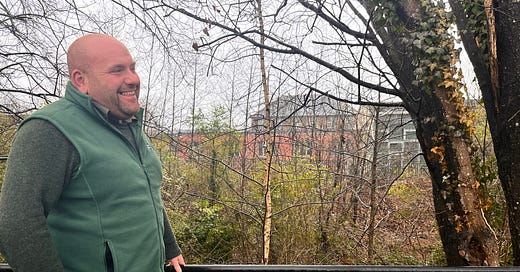multi-storied #27: The cross-training writer
Regulars at any gym will be familiar with the advice to not skip leg day. This is how gyms hook you, of course: by convincing you that different parts of your body need to be trained separately, and that training all of them, one part after another, will require a five-year membership minimum, lockers not included. Sadly, this seems to be medically valid as well. You need to run fast, run slow, stretch, jump, curl, push up, pull down, press, row, squat… The verbs are endless.
Writing provides a reasonable analog of this. The Internet is full of blah advice about writing being a muscle, when in fact it is a collection of several muscles, each of which can be exercised by itself. Unlike the gym, this is utterly enjoyable, and magazine writers, in particular, have plenty of fun in varying the form and tone of their pieces. This kind of cross-training is always something I yearn to do. If I’ve written two successive pieces that lean political, I will want to tilt towards culture next. The subjects of some pieces hold no opportunity to be funny or light—a particular problem in 2020; the subjects of other pieces, thankfully, do. If, in a year, one piece is a character study, the next is an analytical essay, and the third is more literary, that year is richer for it.
Last year, I jumped at an editor’s suggestion for a piece purely so that I could work a different set of muscles. In its earliest conception, it was just an idea about Japanese knotweed, commonly maligned as the plant that ate Britain’s gardens. Since its arrival in the country in the mid-19th century, knotweed has overrun the land. It’s well-nigh unkillable, and difficult even to tame. According to one estimate, 5% of UK homes are afflicted with knotweed, potentially slicing £20 billion off their collective value. There are so many lawyers filing knotweed complaints today that one person described them to me as “wheelbarrow chasers.”
Sometimes you have a feeling about a story, or about the form it can take—or the form that best serves it. My previous piece for the Guardian had been a hard, quite technical look at a nuclear power plant. This one, I thought, offered another kind of workout, of muscles I hadn’t used in a while. I could do rich description of the natural world, which is always a joy in a place like England. I could be more wry in some spots, more anecdotal in others, and more essayistic in still others. I could spend enough time with people to get a sense of their character—something that wasn’t possible, or even necessary, in writing about the Sellafield plant. Half the time, I sometimes think, I’m picking projects less because of their subjects and more because of what they promise by way of form and tone.
It all reminded me of another piece I’d written, years ago, when we were all being flooded by real estate spam text messages in India and I decided to follow up some of these “offers” and write about what I found. (I’ll send that out here another time.) You have to sweat to make the average reader care about the decommissioning of a nuclear plant. But that same reader is already invested when you write about a weed in everyone’s garden, or about spam SMS that everyone receives. That feels liberating; it lightens you up, it makes things fizz.
But.
The more you follow an idea, the more it tends to surprise you. The article on knotweed did turn out to exercise largely the muscles I’d expected. But just as some leg days unexpectedly work your lower back, this piece found its way into a different register at the end: a quieter, almost melancholic coda. It was all thanks to Koichi Watanabe, a Japanese photographer. That little excerpt is below the Share button. The full piece, again, is here:
In Japan, knotweed has an altogether more poetic name: itadori. One translation of the word is “tiger cane”, perhaps referring to the way a stand of tall dead canes resembles a tiger’s striped back. Its native ecosystem imposes more limits on knotweed. Silvergrass and bamboo vie strongly with it for water and soil nutrients. A species of psyllid, an insect not much bigger than the head of a nail, feeds exclusively on knotweed sap, weakening and killing the plant. Even so, itadori grows luxuriantly, ever ready to annex neglected land. When the photographer Koichi Watanabe was a boy, living outside Osaka, he passed a deep wood of black locust trees along the river on his way to school. One year, the trees were all cut down. The very next spring, the riverbank swarmed with a plant that Watanabe didn’t recognise, its buds like asparagus tips and its leaves shaped like hearts. Itadori, rife as life.
For 20 years, Watanabe has been roving the world, photographing knotweed. He calls his project Moving Plants; it fascinates him that plants, so easy to regard as rooted and stable, traverse geographies simply by getting entangled in the lives of humans. His knotweed groves are always centred in long horizontal panoramas, he said, so that the frame can include signs of human existence as well. His earliest photos were taken in the vicinity of Osaka, and across the island of Hokkaido. By and large, the inhabitants of these areas, and indeed of the rest of Japan, regard itadori with indifference, Watanabe said. The plant’s ornamental value is very slight; he has only ever seen it in a flower shop once, in Kyoto. Some supermarkets stock itadori leaf tea, itadori jam and itadori pickles – products that derive an unexpected utility out of knotweed. For Japan’s civic authorities, although maybe not for its public at large, knotweed is certainly a pest, if only one of several. Routinely, it has to be cleared from riverbanks and farms, Watanabe told me. “We do think it’s a weed. It’s just that we don’t want to kill it everywhere,” he said. “When I heard the words ‘eradicate’ or ‘kill’ in England, I was shocked.”
One possible reason for this forbearance is that knotweed, restrained by its habitat, rarely invades the gardens of Japanese homes. Daisuke Kurose, a plant pathologist who mapped knotweed across southern and northern Japan, said he’d never seen knotweed in private properties, even in the countryside. “As a result, people usually don’t care too much about it,” Kurose, who now works in Surrey for the agricultural non-profit Cabi, told me. “I used to give lectures to university students, and I’d ask them if they knew what itadori is. Most of them would guess that it is a kind of bird, because ‘dori’ is so similar to the Japanese word for bird.” When he came to Cabi, Kurose said, he always felt a twinge of regret that the word “Japanese” was appended to the weed that made people’s lives so hard. “But at the same time, I felt bad for British people, too, because I know knotweed is strong and difficult to eradicate.”
Watanabe has followed the trail of knotweed to the UK, Poland, the Netherlands and both coasts of the US. He hasn’t visited France or Sweden, where knotweed has spread widely. In Sweden, where the plant is called “parkslide” and where it has been found as far north as 65 degrees latitude, the milder winters to come will only encourage knotweed further. Jonathan Lindgren, an executive at Villaägarna, an association of Swedish homeowners, told me about his increasingly frantic conversations with municipalities beset by knotweed. “They try a lot of things. Like, some of them started trying to get pigs to eat knotweed. But usually these projects end in silence,” Lindgren said. “What I hear, though, is that knotweed is a growing problem and a losing battle.” One of Lindgren’s chief exasperations is that knotweed contains resveratrol, a compound also found in wine and hyped for its health benefits. “Some circles here are so fascinated with knotweed that they almost think it has spiritual properties,” Lindgren said. “So there are YouTube videos and blogs where people recommend how to grow knotweed, or how to make pie out of it. I mean, imagine: people are growing knotweed on purpose!”
Chris van Dijk, the Dutch knotweed researcher, often spots knotweed growing out of the cracks of Amsterdam’s canals, the rhizome enlarging the damage so much that, he fears, “parts of the walls will collapse and fall into the water”. Rotterdam’s harbour was plagued by such thick knotweed colonies that they had to be excavated, he said, “and they now have a depot of 120,000 cubic metres of contaminated soil”. One Watanabe print shows a geyser of knotweed erupting out of other foliage in Leiden. In Poland, Watanabe said, he found the worst cases of blight he’d seen in any country, the plant sometimes invading wheat fields or choking irrigation canals. The most extreme of Watanabe’s photos give the impression of some colossal digestive action frozen mid-process. In one eerie photo, shot in upstate New York, knotweed has engulfed the base of a house, pouring in through one side and out the other. Only the house’s upper floor is visible; left untended, it too will vanish into the innards of the knotweed stand.
Touring these sites, Watanabe wrote in 2015: “I caught the odd feeling that I had come to the future world from which human beings had departed. Vegetation would be renewed year after year if people were gone and constructions were demolished. Hybridised itadori would be the main creature in this area.” But these didn’t feel, to him, like outtakes of a vegetal apocalypse. Instead, Watanabe developed a silent communion with his subject, admiring the way its leaves shook in the breeze, and eventually learning to sympathise with it. Too often, he told me, people speak about knotweed as if it were a virus: “It appears in the metaphor of ‘itadori infestation’ or ‘itadori as pest’.” The truth is, he said, that humans are responsible – for setting knotweed loose across the planet, and then for losing their minds about its presence. “The itadori is not guilty,” Watanabe said. “It is just living.”





